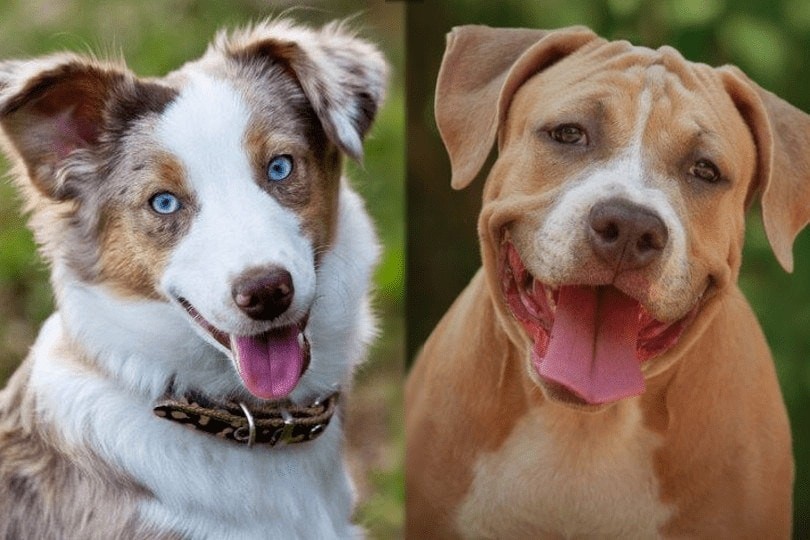
The Australian Shepherd Pitbull Mix, also known as the Aussie Pit, represents a fascinating blend of two distinctly different yet complementary breeds. This designer hybrid combines the Australian Shepherd's legendary herding instincts and intelligence with the Pitbull's strength and unwavering loyalty. First emerging during the late 20th century's mixed-breed trend, these dogs exhibit a unique combination of physical and behavioral traits from both parent breeds. While they can make excellent companions for active families, their high energy levels, strong work drive, and need for consistent training make them best suited for experienced dog owners who can provide adequate exercise and mental stimulation.
Understanding the Australian Shepherd Pitbull Health and Genetics
Genetic Health Considerations
The Australian Shepherd Pitbull mix requires careful consideration of inherited genetic traits. A key concern is the Merle gene present in both parent breeds, which can lead to vision and hearing defects when inherited from both parents. Cerebellar ataxia, primarily inherited from the Pitbull parent, may manifest around age three and affects brain function. The mix is also prone to Collie eye anomaly and epilepsy from both parent lines.
Resistance and Disease Prevention
This hybrid may develop lower disease resistance compared to purebred parents. While some mixed breeds exhibit hybrid vigor, the Australian Shepherd Pitbull combination can potentially inherit health vulnerabilities from both parent breeds. To minimize health risks, prospective owners should:
- Work with licensed breeders offering health guarantees
- Request genetic testing documentation for parent dogs
- Schedule regular veterinary screenings for early detection
- Maintain preventive healthcare through proper nutrition and exercise
- Monitor for signs of inherited conditions like hip dysplasia and eye problems
The key to managing these health concerns lies in proactive health screening and responsible breeding practices that prioritize genetic diversity while minimizing the expression of harmful inherited traits.
Physical Characteristics and Temperament\nHealth Concerns and Care Requirements
Physical Build and Appearance
The Australian Shepherd Pitbull mix combines the athletic build of both parent breeds, featuring a muscular yet agile physique. Standing between 17-23 inches tall with a weight range of 40-70 pounds, these dogs display a well-proportioned body with a strong stance. Their eyes can be striking, with some inheriting the Australian Shepherd's characteristic blue or heterochromatic coloring. The ears may be either floppy like the Pitbull's or semi-erect like the Aussie's, while the facial structure typically shows a blend of both breeds' features with a broad skull and defined jaw.
Personality Traits and Exercise Needs
While the previous sections covered health aspects, this section focuses specifically on behavioral characteristics. The Australian Shepherd Pitbull mix exhibits high intelligence combined with an energetic disposition, requiring 1-2 hours of daily physical activity. Their temperament reflects a unique blend of the Pitbull's confidence and the Australian Shepherd's work ethic, making them highly trainable but sometimes stubborn. These dogs form strong bonds with family members while maintaining a protective nature. However, their herding instincts can lead to chasing behaviors, particularly with moving objects or young children. Regular mental stimulation through puzzle toys and training exercises is essential to prevent destructive behaviors stemming from boredom.
Living Environment and Training Essentials
Space and Housing Requirements
While previous sections covered physical traits and health, this section focuses on specific living conditions needed. The Australian Shepherd Pitbull mix requires adequate space for their high energy levels. A fenced yard of at least 400-500 square feet is ideal, though they can adapt to apartment living with sufficient exercise. Indoor spaces should be puppy-proofed due to their potential destructive tendencies when bored. Secure fencing at least 6 feet high is essential to prevent escape attempts, as they are known to be skilled jumpers and diggers.
Early Training Priorities
Unlike previous discussions on general training, this section emphasizes critical early training needs. Training should begin immediately upon bringing home an Aussie Pit puppy, focusing on three key areas: impulse control, bite inhibition, and leash manners. Due to their herding background and strong prey drive, these dogs need structured training sessions 2-3 times daily, lasting 10-15 minutes each. Basic obedience commands should be mastered by 16-20 weeks of age. Crate training is particularly important for this mix, providing them with a safe space and helping prevent destructive behaviors when unsupervised. The use of food puzzles and interactive toys during training sessions helps channel their intelligence while preventing boredom-related issues.
Conclusion
The Australian Shepherd Pitbull mix represents a unique hybrid combining the athletic build, intelligence, and energy of both parent breeds. This mix typically stands 17-23 inches tall, weighs 40-70 pounds, and requires significant daily exercise (1-2 hours) along with mental stimulation. While these dogs can make loyal and trainable family companions, they come with important health considerations, including risks related to the Merle gene, cerebellar ataxia, and other inherited conditions that require careful screening and monitoring.
For successful ownership, prospective owners must be prepared to provide adequate space (ideally a securely fenced yard), consistent early training focusing on impulse control and basic obedience, and regular veterinary care to monitor for genetic health issues. The mix's high energy levels, strong herding instincts, and potential for destructive behaviors when understimulated make them best suited for active families who can dedicate time to training, exercise, and mental enrichment. Working with reputable breeders who conduct genetic testing and provide health guarantees is essential for minimizing inherited health risks in this unique hybrid.